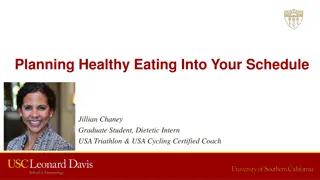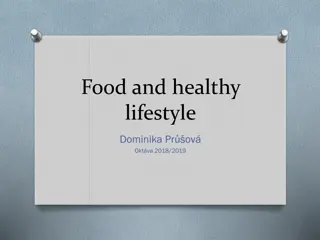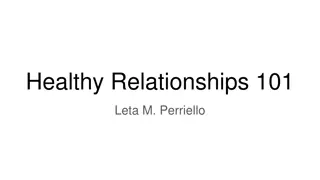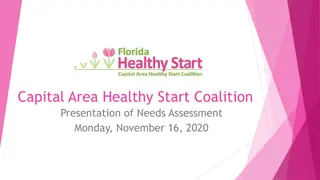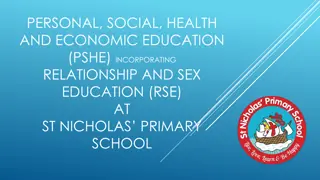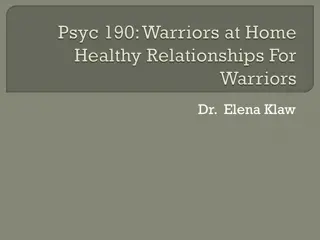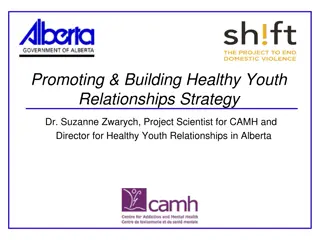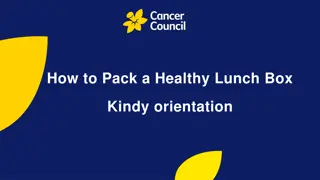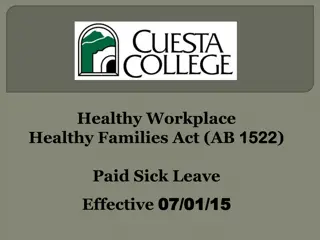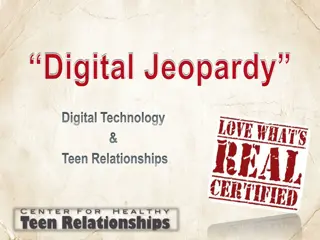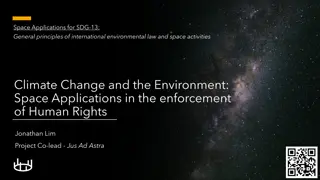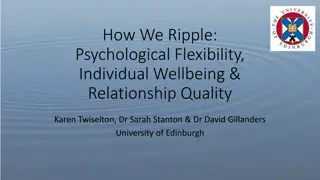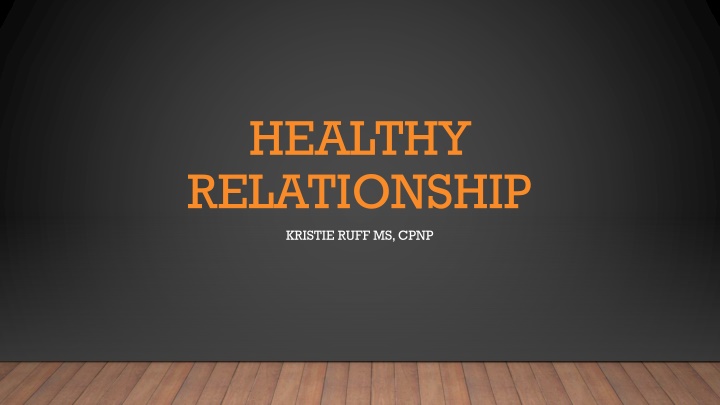
Building Healthy Relationships: Characteristics and Communication Strategies
Explore the characteristics of healthy and unhealthy relationships, learn to identify what you seek in a relationship, and discover effective communication methods that foster understanding and connection. Engage in activities and discussions to enhance your relationship skills.
Download Presentation

Please find below an Image/Link to download the presentation.
The content on the website is provided AS IS for your information and personal use only. It may not be sold, licensed, or shared on other websites without obtaining consent from the author. If you encounter any issues during the download, it is possible that the publisher has removed the file from their server.
You are allowed to download the files provided on this website for personal or commercial use, subject to the condition that they are used lawfully. All files are the property of their respective owners.
The content on the website is provided AS IS for your information and personal use only. It may not be sold, licensed, or shared on other websites without obtaining consent from the author.
E N D
Presentation Transcript
HEALTHY RELATIONSHIP KRISTIE RUFF MS, CPNP
HEALTH RELATIONSHIP The way in which two or more people talk to, behave/act towards or deal with each other.
HEALTH RELATIONSHIP Instructional Objectives Describe characteristics of healthy and unhealthy relationships Identify characteristics of what you are looking for in a relationship
HEALTH RELATIONSHIPS Activity: What I want/don t want in a relationship
HEALTHY RELATIONSHIP Characteristics of a Health Relationship: Characteristics of an Unhealthy Relationship:
COMMUNICATION Instructional Objective: Describe communication in a health relationship
COMMUNICATION Activity: Role play
COMMUNICATION Discussion: Student #1 and the class: Talk about what was going through your mind, how were you feeling and your responded.
COMMUNICATION Healthy communication produces a sense of being understood and feelings of connectiveness between people in relationship.
COMMUNICATION Speaking- Be open and clear about how you are feeling If you don t understand, tell them Use I statements so the other person doesn t feel like you are calling them out or attacking them Be honest, eve if you think the other person might not like hearing how you truly feel Admit and/or apologize when you are wrong or hurt the other person When talking about something negative, start with a positive
COMMUNICATION Listening- Pay attention reducing distractions (put your phone away) Listen to what the other person is saying instead of just thinking about how you will respond Wait for the other person to finish before starting to respond Let the other person know you are listening by use acknowledging words or gestures Asking questions if you don t understand something Don t leave them hanging (if you are thinking about something before responding, let the other person know) Be prepared to hear something that you might not like and really think about it before responding
COMMUNICATION Body language- Make eye contact Give the other person your full attention Lean in as they are speaking New York State Teen Dating Abuse Awareness and Prevention. What does a healthy Relationship Look Like? Retrieved from https://www.ny.gov/teen-dating-violence-awareness-and-prevention/what-does-healthy-relationship-look
COMMUNICATION Activity: Role play
BOUNDARIES Instructional Objectives: Describe boundaries in a healthy relationship Identify and analysis personal boundaries Describe several ways to say NO Demonstrate refusal skills
BOUNDARIES What are personal boundaries? Personal boundaries are guidelines, rules, or limits that a person creates for themselves to identify what are reasonable, safe and acceptable ways for other people to behave/act around them and to treat them. JMR Counseling. Personal Boundaries, Relationship level, and intimacy circle. Retrieved from http://www.jmrlcswc.com/2015/09/personal-boundaries-relationship-levels_34.html
BOUNDARIES Having boundaries is like drawing a line Onside has the things you are okay with The other side thing you are not okay with, don t feel ready for, or make you uncomfortable This line look different for everyone It is important for you to know where you draw yours
BOUNDARIES Categories of Personal Boundaries: Physical: Are you okay with touch? What kind? Where? By whom? When?
BOUNDARIES Categories of Personal Boundaries: Emotional: Are you okay with sharing your feeling right away or do you time to think? Who are you okay sharing your feelings with? What kind of feeling are you willing to share? Is it okay for what you shared to be told to others by someone else?
BOUNDARIES Categories of Personal Boundaries: Digital: Are you okay with sharing your phone? Who do you feel comfortable sharing the password with? Is it okay for a picture of you to be posted on Facebook, snap chat, Instagram etc.?
BOUNDARIES Categories of Personal Boundaries: Spiritual: Who do you feel comfortable sharing your beliefs with? Do you and those you have relation with have to share the same beliefs? New York State Teen Dating Abuse Awareness and Prevention. What does a healthy Relationship Look Like? Retrieved from https://www.ny.gov/teen-dating-violence-awareness-and-prevention/what-does-healthy- relationship-look
BOUNDARIES Circle of intimacy A circle of intimacy helps you determine what types of boundaries, physical and non-physical, are appropriate and what types of behaviors are appropriate or acceptable for each type of relationship. JMR Counseling. Personal Boundaries, Relationship level, and intimacy circle. Retrieved from http://www.jmrlcswc.com/2015/09/personal-boundaries-relationship-levels_34.html
Related image BOUNDARIES Remember, we started our discussion today identifying different types of relationships parent-child, student-teacher, friend, romantic. See how each fall in the circle of intimacy?
BOUNDARIES Activity: Where do I draw the line
Acceptable ways to treat me & behave or act around me Unacceptable ways to treat me & Behave or act around me Touch my buttocks in public Kiss in public Hold hands Stand close to Kiss (in private) BOUNDARIES Example: Type of relationship: Intimate Category of boundary: physical
BOUNDARIES Letting people know your boundaries: Be open and honest
BOUNDARIES How can you respond when your personal boundary has been crossed?
BOUNDARIES Say NO in a firm voice Tell why not Offer other ideas Promptly leave
BOUNDARIES No Thanks Simply say No Broken Record Giving a Reason or Excuse Cold Shoulder Changing the Subject Reversing the Pressure Other cool ways to say No Refusal skill (n.d.). Retrieved from https://www.uen.org/preventiondimensions/downloads/lessons/sixth/Lesson15-RefusalSkills.pdf
BOUNDARIES Activity: Ways of Saying NO!
HEALTH RELATIONSHIP We have spent the last period talking about health relationships. You were able to describe characteristics of what a health relationship looks like as well as those of an unhealthy relationship. You were able to identify what characteristics you are looking for in a relationship We discussed two major components of health relationships: communication & personal boundaries You were able to describe as well as identify health communication
HEALTH RELATIONSHIPS You were able to describe personal boundaries including 4 different categories of boundaries: physical, emotional, spiritual, digital and spiritual You were able to begin to analysis your own personal boundaries We discussed ways to say NO! You were able to describe as well as demonstrate ways to say NO! such as the STOP method, No Thanks, broke record, giving a reason or excuse, cold shoulder, changing the subject, and reversing the pressure.


